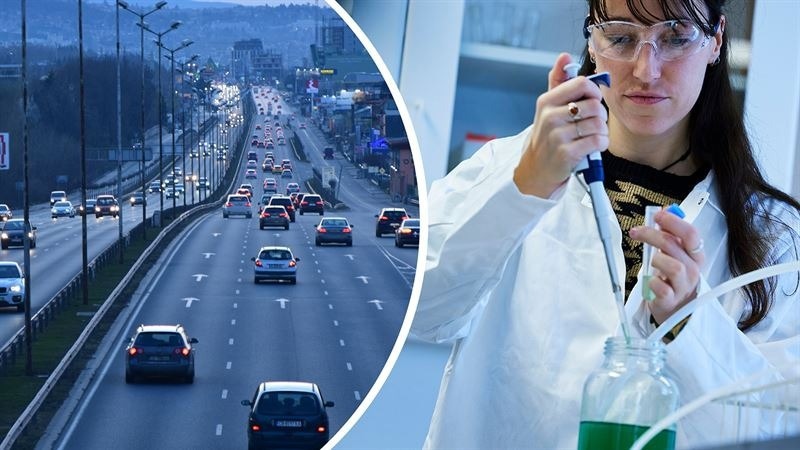Researchers at Chalmers University of Technology in Sweden have introduced an innovative and highly efficient method for recycling metals from used electric car batteries.

Researchers at Chalmers University of Technology, Sweden, are now presenting a new and efficient way to recycle metals from spent electric car batteries. Léa Rouquette, PhD student at Chalmers, is the first author of the new study. Image Credit: Pixabay | Zdravko Shishmanov and Chalmers | Anna-Lena Lundqvist
This approach enables the recovery of 100% of the aluminum and 98% of the lithium contained in these batteries. Importantly, it also minimizes the loss of valuable raw materials like nickel, cobalt, and manganese. What sets this process apart is that it does not rely on costly or harmful chemicals; instead, it utilizes oxalic acid, an organic acid commonly found in the plant kingdom.
So far, no one has managed to find exactly the right conditions for separating this much lithium using oxalic acid, whilst also removing all the aluminum. Since all batteries contain aluminum, we need to be able to remove it without losing the other metals.
Léa Rouquette, PhD Student, Department of Chemistry and Chemical Engineering, Chalmers University of Technology
In Chalmers' battery recycling laboratory, researchers led by Martina Petranikova demonstrated the new recycling method. They started with spent car battery cells and proceeded to pulverize their contents. This results in a finely ground black powder that is then dissolved in a transparent liquid, oxalic acid. Rouquette combined both the powder and the liquid in a process reminiscent of using a kitchen mixer.
While it may appear as straightforward as brewing coffee, the precise procedure represents a recent and unique scientific breakthrough. The researchers have developed a remarkable new recipe for utilizing oxalic acid, an environmentally friendly substance found in plants like rhubarb and spinach.
This recipe involves fine-tuning parameters such as temperature, concentration, and time to optimize the recycling process.
We need alternatives to inorganic chemicals. One of the biggest bottlenecks in today’s processes is removing residual materials like aluminum. This is an innovative method that can offer the recycling industry new alternatives and help solve problems that hinder development.
Martina Petranikova, Associate Professor, Department of Chemistry and Chemical Engineering, Chalmers University of Technology
Reversing Order and Avoiding the Loss
The aqueous-based recycling technique is known as hydrometallurgy. In traditional hydrometallurgy, all the metals in an electric vehicle (EV) battery cell are dissolved using an inorganic acid.
Then, “impurities” like aluminum and copper are removed. Finally, valuable metals such as cobalt, nickel, manganese, and lithium are recovered separately. Although the amount of remaining aluminum and copper is small, this process involves multiple purification steps, and each step can lead to the loss of lithium.
With the new method, researchers reverse the order of recovery, starting with the extraction of lithium and aluminum. This approach allows for a reduction in the waste of valuable metals required to manufacture new batteries, which is a significant advancement in recycling efficiency.
The latter part of the process, involving the filtration of the black mixture, shares similarities with brewing coffee. During this step, aluminum and lithium end up in the liquid, while the other metals remain in the “solids.” The subsequent phase of the process involves the separation of aluminum and lithium from these respective fractions.
“Since the metals have very different properties, we don’t think it’ll be hard to separate them. Our method is a promising new route for battery recycling – a route that definitely warrants further exploration,” notes Rouquette.
As the method can be scaled up, we hope it can be used in industry in future years.
Martina Petranikova, Associate Professor, Department of Chemistry and Chemical Engineering, Chalmers University of Technology
Petranikova's research group has dedicated numerous years to pioneering research in the recycling of metals contained in lithium-ion batteries. The group actively collaborates with companies to advance the recycling of electric car batteries and is a partner in substantial research and development initiatives, including projects like Volvo Cars' and Northvolt's Nybat project.
Journal Reference
Rouquette, L. M. J., et al. (2023). Complete and selective recovery of lithium from EV lithium-ion batteries: Modeling and optimization using oxalic acid as a leaching agent. Separation and Purification Technology. doi.org/10.1016/j.seppur.2023.124143.